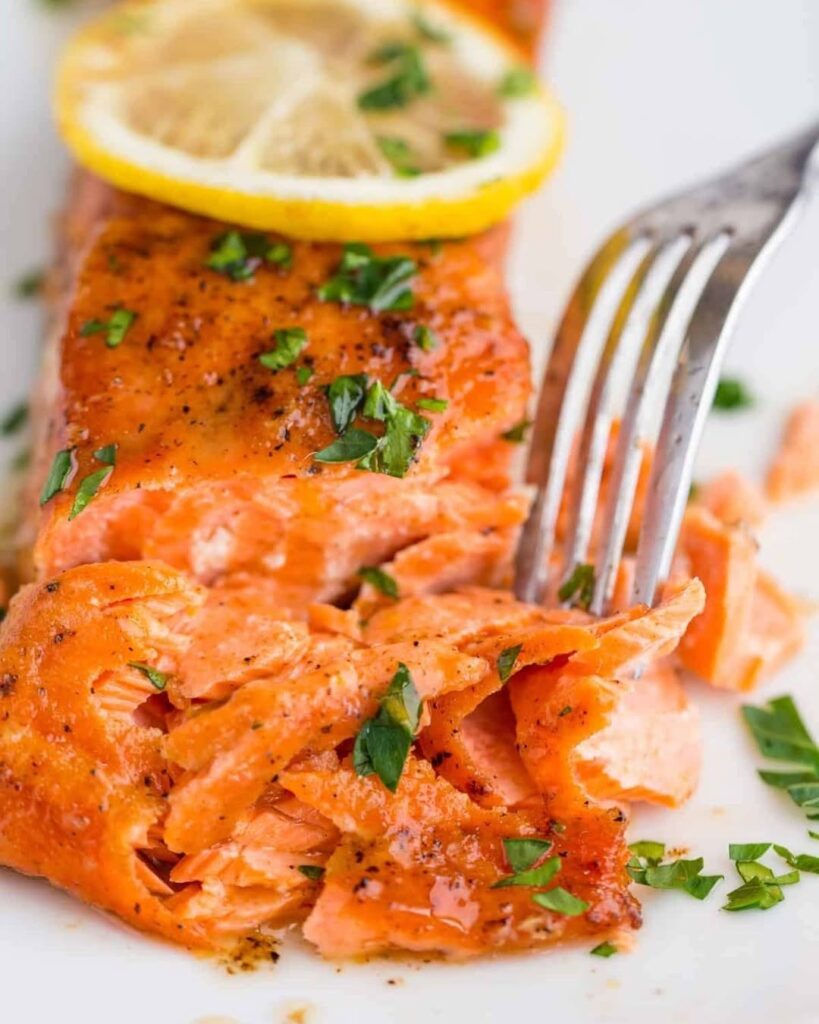Salmon is a powerhouse of nutrients, rich in omega-3 fatty acids, protein, and essential vitamins. Cooking salmon in an air fryer offers a simple, fast, and flavorful way to prepare this nutritious fish without compromising on taste or texture. The Skinny Taste Air Fryer Salmon Recipe is a go-to for busy weeknights or elegant dinners. This recipe combines a well-balanced seasoning blend with the convenience of air frying to create perfectly cooked salmon every time.
In this guide, you’ll find detailed instructions, nutritional information, and all the steps to make this incredible dish. Whether you’re new to air frying or a seasoned pro, this recipe will become a staple in your meal rotation.

Introduction to the Recipe
The Skinny Taste Air Fryer Salmon Recipe is a light and healthy dish that emphasizes the natural flavors of salmon while keeping the preparation easy and fuss-free. With just a handful of ingredients, you can create a meal that is not only quick but also packed with nutrients. Air frying ensures a crispy exterior and a tender, flaky interior, making it a healthier alternative to pan-frying or baking with excessive oil.
Whether you’re cooking for yourself, your family, or hosting a dinner party, this recipe is versatile enough to fit the occasion. Plus, it caters to a variety of dietary preferences, making it ideal for those following low-carb, keto, or gluten-free diets.
Recipe Overview
- Cuisine: American
- Course: Main Dish
- Servings: 4
- Calories: Approximately 250 per serving
- Prep Time: 5 minutes
- Active Cook Time: 8-10 minutes
- Resting Time: 2 minutes
- Total Time: 17 minutes
Ingredients
To make this recipe, you’ll need:
- 4 salmon fillets (approximately 6 ounces each, skin-on or skinless)
- 1 tablespoon olive oil
- 1 teaspoon garlic powder
- 1 teaspoon paprika
- 1/2 teaspoon salt
- 1/2 teaspoon black pepper
- 1 teaspoon dried parsley (optional for garnish)
- Lemon wedges (for serving)
Equipment
- Air fryer
- Small mixing bowl
- Silicone brush or spoon
- Tongs
- Meat thermometer
Nutrition Facts (Per Serving)
- Calories: 250
- Protein: 25g
- Carbohydrates: 1g
- Fat: 16g
- Fiber: 0g
- Sugars: 0g
- Omega-3 Fatty Acids: High
Instructions for Skinny Taste Air Fryer Salmon Recipe
Step 1: Prepare the Salmon
- If your salmon fillets have skin, make sure to pat them dry with a paper towel to remove excess moisture.
- Place the salmon fillets on a clean plate or tray.
- Drizzle olive oil over each fillet and use a silicone brush or your fingers to coat them evenly.
Step 2: Mix the Seasoning
- In a small mixing bowl, combine garlic powder, paprika, salt, and black pepper.
- Sprinkle the seasoning mixture evenly over the salmon fillets, pressing gently to adhere.
Step 3: Preheat the Air Fryer
- Preheat your air fryer to 400°F (200°C) for 3 minutes. This ensures even cooking and a perfectly crispy exterior.
Step 4: Cook the Salmon
- Place the seasoned salmon fillets in the air fryer basket, skin-side down if applicable. Avoid overcrowding the basket to allow proper air circulation.
- Air fry at 400°F (200°C) for 8-10 minutes, depending on the thickness of the fillets.
- For fillets approximately 1 inch thick, 8 minutes should suffice.
- Use a meat thermometer to check for doneness; the internal temperature should reach 145°F (63°C).
Step 5: Rest and Serve
- Once the salmon is cooked, remove it from the air fryer using tongs and let it rest for 2 minutes. This helps retain its juices.
- Garnish with dried parsley (optional) and serve with fresh lemon wedges for a burst of citrus flavor.
Tips for Success
- Don’t Overcook: Air fryers cook food quickly, so keep a close eye on the cooking time. Overcooked salmon can become dry.
- Choose Fresh Salmon: Fresh, high-quality salmon enhances the flavor and texture of this dish.
- Experiment with Seasonings: Feel free to customize the spice blend by adding cayenne pepper for heat or using smoked paprika for a deeper flavor.
Serving Suggestions
The Skinny Taste Air Fryer Salmon Recipe pairs well with a variety of side dishes. Here are some ideas:
- Steamed Vegetables: Broccoli, asparagus, or green beans add a crunchy, healthy side.
- Quinoa or Brown Rice: For a more filling meal, serve the salmon with a hearty grain.
- Fresh Salad: A mixed greens salad with a light vinaigrette complements the salmon beautifully.
- Mashed Cauliflower: For a low-carb alternative, pair it with creamy mashed cauliflower.
Why Choose Air Fryer for Cooking Salmon?
Cooking salmon in an air fryer is one of the healthiest and quickest methods available. Unlike frying in oil or baking in butter, air frying uses little to no oil while achieving the same crispy texture. Additionally, the air fryer evenly circulates heat, ensuring perfectly cooked salmon without flipping or constant monitoring.
FAQs
- Can I use frozen salmon?
Yes, but thaw it first for even cooking. Pat it dry thoroughly before seasoning. - What other seasonings can I use?
Lemon pepper, dill, or even a honey-soy glaze work wonderfully. - Can I store leftovers?
Store cooked salmon in an airtight container in the refrigerator for up to 3 days. Reheat in the air fryer for 2-3 minutes for best results.
Conclusion
The Skinny Taste Air Fryer Salmon Recipe is an easy, nutritious, and flavorful meal option that fits perfectly into any busy lifestyle. With minimal prep time and a short cooking duration, you can have a delicious, restaurant-quality dish on your table in under 20 minutes. Whether you’re a health-conscious eater or simply looking for a quick dinner idea, this recipe ticks all the boxes.
Give it a try and enjoy the perfect combination of crispy, flaky, and flavorful salmon!

I am Ashley Doyle, Senior Specialist in Food & Policy at The Humane Society of the United States and editor at airfryermama.com. I am passionate about transforming our global food system by promoting delicious, climate-friendly, plant-based foods. After transitioning from law to food and public policy, I now work with major food service companies to develop plant-based initiatives and animal welfare policies. My goal is to drive institutional change to combat climate change and improve our food system.
